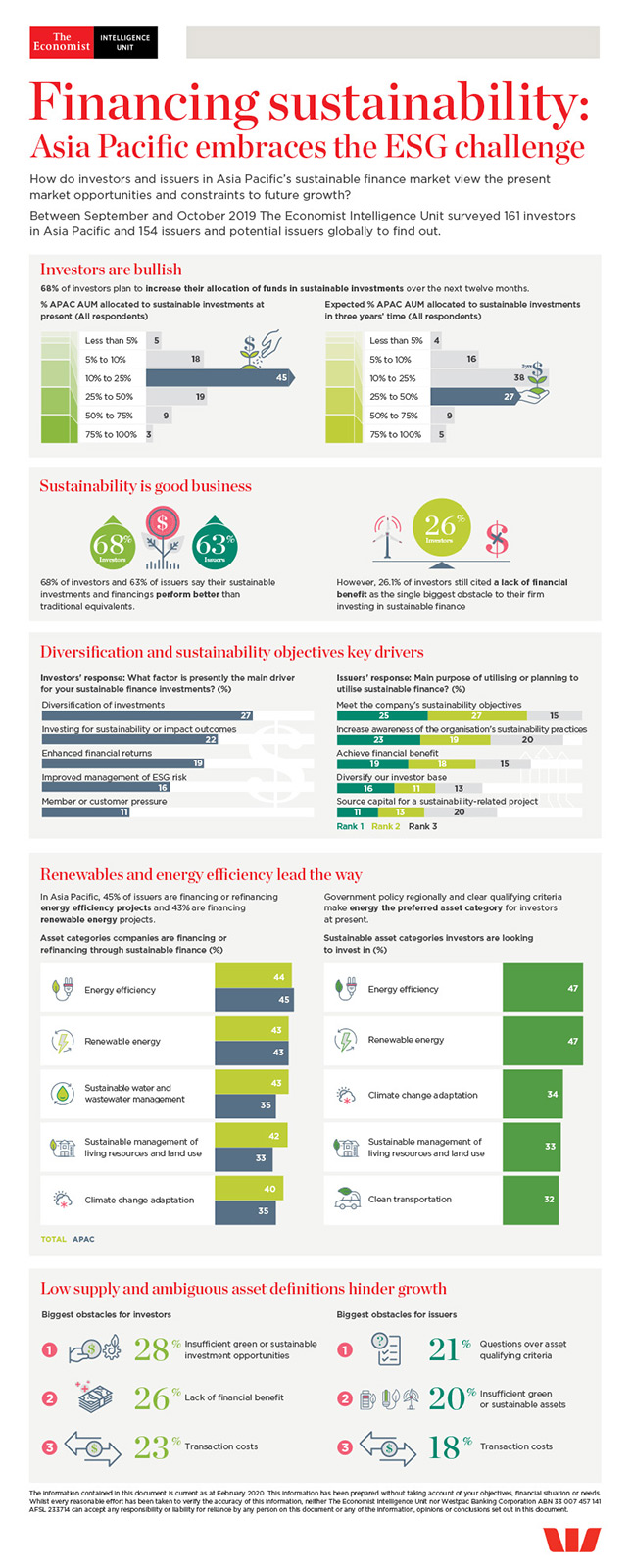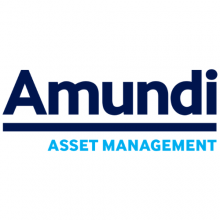Financing sustainability | Insights video
What is driving the strong demand for financing sustainability in Asia Pacific? How can companies increase supply and start to see the benefits of sustainable finance in the next three years? We interviewed Richard Brandweiner, CEO of Pendal Australia, and Sophia Cheng, CIO of Cathay Financial Holdings and chair of Asia Investor Group on Climate Change, to find out.
Related content

Financing sustainability: Asia Pacific embraces the ESG challenge
Financing sustainability: Asia Pacific embraces the ESG challenge is an Economist Intelligence Unit report, sponsored by Westpac. It explores the drivers of sustainable finance growth in Asia Pacific as well as the factors constraining it. The analysis is based on two parallel surveys—one of investors and one of issuers—conducted in September and October 2019.
If the countries of Asia Pacific are to limit the negative environmental effects of continued economic growth, and companies in the region are to mitigate their potential climate risks and make a positive business contribution through improving the environment and meeting the UN's Sustainable Development Goals (SDGs), large volumes of investment in sustainable projects and businesses need to be mobilised. A viable sustainable finance market is taking shape in the region to channel commercial investor funds, and both investors and issuers say they are achieving a financial benefit from their investment and financing activities. The market is still in the early stages of development, however, and must expand and mature to meet investor needs.
The chief constraint on sustainable finance growth in the region has been the limited supply of bankable sustainable projects. Our research suggests supply is increasing, but with investor demand continuing to grow apace, the gap will remain an obstacle in the short- to medium-term. Among the organisations in our issuer survey, only 7% have used sustainable finance instruments to fund projects. However, nearly nine in ten (87%) said they intend to do so in the next year, which should begin to bridge the gap between supply and demand.
Based on issuers’ stated intentions, investors will have a range of instruments to choose from, including green loans and bonds and sustainability loans and bonds. Large numbers of investors indicate that they intend to deploy a greater proportion of capital to these over the next three years.

Financing sustainability | Infographic
Financing sustainability: How do investors and issuers in APAC's sustainable finance market view the present market opportunities and constraints?
To learn more:
Download report | Watch video
Fintech in ASEAN
To better understand the opportunities and challenges in developing a fintech business in seven ASEAN markets, The Economist Intelligence Unit conducted wide-ranging desk research supplemented by seven in-depth interviews with executives in Australia and ASEAN.
Download report and watch video interview to learn more.
Financing sustainability: How do investors and issuers in APAC's sustainable finance market view the present market opportunities and constraints?

To learn more:
Related content

Financing sustainability: Asia Pacific embraces the ESG challenge
Financing sustainability: Asia Pacific embraces the ESG challenge is an Economist Intelligence Unit report, sponsored by Westpac. It explores the drivers of sustainable finance growth in Asia Pacific as well as the factors constraining it. The analysis is based on two parallel surveys—one of investors and one of issuers—conducted in September and October 2019.
If the countries of Asia Pacific are to limit the negative environmental effects of continued economic growth, and companies in the region are to mitigate their potential climate risks and make a positive business contribution through improving the environment and meeting the UN's Sustainable Development Goals (SDGs), large volumes of investment in sustainable projects and businesses need to be mobilised. A viable sustainable finance market is taking shape in the region to channel commercial investor funds, and both investors and issuers say they are achieving a financial benefit from their investment and financing activities. The market is still in the early stages of development, however, and must expand and mature to meet investor needs.
The chief constraint on sustainable finance growth in the region has been the limited supply of bankable sustainable projects. Our research suggests supply is increasing, but with investor demand continuing to grow apace, the gap will remain an obstacle in the short- to medium-term. Among the organisations in our issuer survey, only 7% have used sustainable finance instruments to fund projects. However, nearly nine in ten (87%) said they intend to do so in the next year, which should begin to bridge the gap between supply and demand.
Based on issuers’ stated intentions, investors will have a range of instruments to choose from, including green loans and bonds and sustainability loans and bonds. Large numbers of investors indicate that they intend to deploy a greater proportion of capital to these over the next three years.

Financing sustainability | Insights video
What is driving the strong demand for financing sustainability in Asia Pacific? How can companies increase supply and start to see the benefits of sustainable finance in the next three years? We interviewed Richard Brandweiner, CEO of Pendal Australia, and Sophia Cheng, CIO of Cathay Financial Holdings and chair of Asia Investor Group on Climate Change, to find out.
To learn more: Download report | View infographic
Fintech in ASEAN
To better understand the opportunities and challenges in developing a fintech business in seven ASEAN markets, The Economist Intelligence Unit conducted wide-ranging desk research supplemented by seven in-depth interviews with executives in Australia and ASEAN.
Download report and watch video interview to learn more.
Social impact: what does it mean, and how should we measure it?
Related content

Resetting the agenda: How ESG is shaping our future
The Covid-19 pandemic has exposed a wealth of interconnections – between ecological and human wellbeing, between economic and environmental fragility, between social inequality and health outcomes, and more. The consequences of these connections are now filtering through, reshaping our society and economy.
In this setting, the need to integrate environmental, social and governance (ESG) factors when investing has become even more critical. Institutional investors must employ ESG not just to mitigate risks and identify opportunities, but to engage with companies to bring about the positive change needed to drive a sustainable economic recovery in the post-Covid world.
In order to understand how ESG could be both a new performance marker and a growth driver in this environment, as well as how institutional investors are using ESG to make investment decisions and to assess their own performance, The Economist Intelligence Unit (EIU), sponsored by UBS, surveyed 450 institutional investors working in asset and wealth management firms, corporate pension funds, endowment funds, family offices, government agencies, hedge funds, insurance companies, pension funds, sovereign wealth funds and reinsurers in North America, Europe and Asia-Pacific.
Download the report and infographic to learn more.

Charting the course for ocean sustainability in the Indian Ocean Rim
Charting the course for ocean sustainability in the Indian Ocean Rim is an Economist Intelligence Unit report, sponsored by Environment Agency Abu Dhabi and the Department of Economic Development Abu Dhabi, which highlights key ocean challenges facing the Indian Ocean Rim countries and showcases initiatives undertaken by governments and the private sector in the region to address these challenges.
Click here to view the report.

Fixing Asia's food system
The urgency for change in Asia's food system comes largely from the fact that Asian populations are growing, urbanising and changing food tastes too quickly for many of the regions’ food systems to cope with. Asian cities are dense and are expected to expand by 578m people by 2030. China, Indonesia and India will account for three quarters of these new urban dwellers.
To study what are the biggest challenges for change, The Economist Intelligence Unit (EIU) surveyed 400 business leaders in Asia’s food industry. According to the respondents, 90% are concerned about their local food system’s ability to meet food security needs, but only 32% feel their organisations have the ability to determine the success of their food systems. Within this gap is a shifting balance of responsibility between the public and private sectors, a tension that needs to and can be strategically addressed.
UK elections: It’s now or never for climate change and the environment
Related content

The Road to Action: Financial regulation addressing climate change
The cost of inaction: Recognising the value at risk from climate change, a July 2015 report written by The Economist Intelligence Unit (The EIU) and sponsored by Aviva, identified the need for a framework to govern the disclosure of climate-related financial risk.
Since that report was published, several significant events have taken place including the historic agreement on a global warming limit at the Paris Climate Conference (officially known as the 21st Conference of the Parties, or COP21), its early adoption by 55 countries and the European Union and the US administration's subsequent decision to withdraw its support from the agreement.
In this follow-up report, also sponsored by Aviva, we review the issues relating to climate-related financial disclosure and investigate the mandates of ten different international, EU and UK financial institutions, all with very different focuses and mandates, to consider what role they play, or could play, in supporting climate-related financial risk reporting.
We also review the recommendations put forward by the TCFD and consider how climate-related financial disclosure can be set into the UN’s broader Sustainable Development Goals (SDGs), rather than being siloed into green finance-related policies and regulations.
Key findings from the report include:
Banks, asset managers, industry and governments—and, in the US, individual states—will continue to need to work with regulators to determine what information is required to ensure that investors have sufficient knowledge of the risks affecting their portfolios, and which regulatory authority will be held accountable to implement such rules. Based on their collective and individual commitments to ensuring financial stability, global, regional and national standard-setting and regulatory institutions can all play a role in ensuring that the Paris target is met. There remains a lack of international consensus on what constitutes a material climate risk, particularly at the sector, subsector and asset-class level. Reporting on materiality is therefore ambiguous and unregulated. Internationally accepted, integrated accounting standards which incorporate climate-change-related risks would reduce investor and financial stability risks. Standardised and regulated scenario analysis is needed to allow asset owners and asset managers to understand how climate change would affect investment return.
Green Finance: Making the Transition to a Climate-Resilient Future

Green Finance: Making the Transition to a Climate-Resilient Future
Green intelligence: Asia’s ESG investing, data integrity and technology
Related content

The China position: Gauging institutional investor confidence
The China position: Gauging institutional investor confidence is an Economist Intelligence Unit report, comissioned by Invesco. It analyses results from a survey of 411 institutional investor and asset owner organisations (approximately 200 in Europe, Middle East and Africa, 100 in North America, and 100 from Asia-Pacific). The key findings of the survey are as follow:
A majority (nine in ten) of our survey respondents claim some level of dedicated exposure to China. Investments are growing; about half of respondents with dedicated China exposure report their investments have “risen significantly” in the past 12 months. Equities are the most-cited way organisations invest in China. Over 60% of respondents with dedicated China exposure report both equities and fixed income onshore holdings. Respondents cited improvements to their own China expertise as the top driver for dedicated investment exposure. Nearly four in ten respondents say environmental, social and governance (ESG) factors play a role in all of their investment decisions; fewer than three in ten say ESG is particularly important for China investments. Chinese asset classes in our survey could see increased investment from foreign organisations over the next 12 months, with respondents highlighting technology, financial services and “new economy” sectors as most attractive. Risk assessments are largely even across asset classes, but on a regional split respondents in APAC are more concerned than counterparts in North America or EMEA. Respondents are mixed on the impact of US-China trade tensions, with similar numbers expecting a positive or negative effect. But a majority of respondents report that their organisations expect to increase exposure over the next 12 months, regardless of outlook. About three-quarters of survey respondents say China’s economy will improve over the next 12 months; about two-thirds say the same for global economic conditions.Our thanks are due to the following individuals for their time and insights:
Jimmy Chang, chief investment strategist, Rockefeller Capital Management Mark Delaney, deputy chief executive and chief investment officer, Australian Super Kevin Wade, chief investment officer, Superannuation Arrangements of the University of London (SAUL)Download the report for more insights.

China icebergs: Forces that could reshape the world
China icebergs: Forces that could reshape the world is an Economist Intelligence Unit report, sponsored by PineBridge Investments, that examines hidden strengths in the Chinese economy—“icebergs”—that existing and potential investors into the world’s second-largest economy should be watching.
The US may have held its position as the world’s largest economy since 1871, but in the 1820s the world’s economic powerhouse was China, at almost 20 times the size of US GDP. China’s decline began in the 19th century and lasted until the country’s economic reforms that began in 1979. Since then, China has rapidly re-emerged as a major economy.China’s boom has helped fuel global growth, but it has also raised the country’s debt levels and prompted questions about economic endurance and global impact. Trends may be visible on the surface, but, like an iceberg, bigger implications lie underneath. To get a better understanding, this report aims to go below headline numbers and explore the nation’s commercial strengths and potential weaknesses. Key takeaways include:
The economy is shifting, and consumers are the driving force. Liberalisation of the private sector is shifting China from a state-backed to a consumption-led economy, which could fully transition by 2030. Chinese technological advances are compounding. From mobile internet to fintech to artificial intelligence and flying cars, Chinese firms are innovating and advances are feeding into the local economy as well as going global. New growth centres are emerging—exponentially. China’s lower-tier cities are growing fast and catching up to the mega-cities in terms of technology, commerce and infrastructure.What does the emergence of middle-class, digital-savvy consumers, the improving mobility of work and the rapid urbanisation mean for China's economy? We talked to Mr. Chibo Tang from Gobi Partners.

A Whole New World: How technology is driving the evolution of intelligent b...
Across the Asia-Pacific region, governments and regulators are already implementing new strategies to digitise their economies and boost social inclusion. Faster payment networks are spreading, facilitating the adoption of mobile payments and the development of open banking. With mobile payment infrastructure and services already embedded in major economies, Asia-Pacific banks are looking to the next challenge. Digital technology regulations lag other regions but are under review (37% of respondents believe that emerging data regulation will have a major impact on the banking sector) as Asia looks to modernise, diversify and dilute its dependence on international trade.
The race is on
In markets where mobile payments have already taken root, banks and payment processors are battling tech companies on two fronts. They are working to retain their own retail card and current-account customers and attract new users to their apps and e-wallets. They also need to get and keep merchants on their side if they are to reap the economies of scale from a high-volume, low-margin sector.
Competition is intensifying between payment solutions based on application programming interfaces (APIs) and pre-loaded and credit card e-wallets. That may explain why survey respondents see an immediate need to master digital engagement and marketing (37% for 2020) to pull in users and merchants. They also need to be able to respond quickly when Alipay, WeChat Pay, Google and WhatsApp introduce new features (31% for 2020).
In India, app providers are already offering cashbacks, discount vouchers and other features to gain and retain market share. This may leave the smaller players vulnerable, particularly when all that is required to switch services is downloading an app. It is therefore likely that consolidation of this sector will follow. As Vijay Shekhar Sharma, founder and chief executive of Paytm, has pointed out, payments are merely the moat around other, more profitable services. The players with deep pockets will outlive their weaker competitors.
The Monetary Authority of Singapore was met with similar concerns that disruptors would leave the banks unprofitable when it first suggested the introduction of open banking. When the regulator pointed out that tech and fintech firms could already offer faster, simpler and cheaper transaction services, the banks agreed to collaborate on upgrading the banking system, providing all stakeholders operated within the same regulatory environment.
Singapore is set to follow Hong Kong with virtual bank licences; ride-hailing app giant Grab is likely to be among the first applicants. That may worry established banks, but the question remains whether the big tech providers have the capacity to tie up capital in establishing their own bank operations. It is also not clear if they really want to expose themselves to the reputational risks that service interruptions or bad service present if they are the sole provider of such services. Grab already offers loans through a Japanese bank and recently signed up with Citibank to offer branded credit cards.2 If either of those services fail to deliver to consumers, the banks, not Grab, face the wrath of consumers and regulatory authorities.
Yet all Asian regulators are acutely aware of how Alipay and WeChat Pay were able to create an effective duopoly in an unregulated market. Chinese authorities are now bringing in new laws to level the playing field. Other authorities want to lay down the rules first, before such corrective action needs to be taken. As a result, the Chinese payment giants may find new markets tougher to crack when they must operate under tighter licensing and data protection rules.
As Steve Weston, co-founder of Australia’s Volt Bank, says of the Australian Prudential Regulation Authority: “The regulators are focused on ensuring that all banks, including new entrants, are operating in a prudent manner.”
Charting the course for ocean sustainability in the Indian Ocean Rim
Charting the course for ocean sustainability in the Indian Ocean Rim is an Economist Intelligence Unit report, sponsored by Environment Agency Abu Dhabi and the Department of Economic Development Abu Dhabi, which highlights key ocean challenges facing the Indian Ocean Rim countries and showcases initiatives undertaken by governments and the private sector in the region to address these challenges.
Related content

Resetting the agenda: How ESG is shaping our future
The Covid-19 pandemic has exposed a wealth of interconnections – between ecological and human wellbeing, between economic and environmental fragility, between social inequality and health outcomes, and more. The consequences of these connections are now filtering through, reshaping our society and economy.
In this setting, the need to integrate environmental, social and governance (ESG) factors when investing has become even more critical. Institutional investors must employ ESG not just to mitigate risks and identify opportunities, but to engage with companies to bring about the positive change needed to drive a sustainable economic recovery in the post-Covid world.
In order to understand how ESG could be both a new performance marker and a growth driver in this environment, as well as how institutional investors are using ESG to make investment decisions and to assess their own performance, The Economist Intelligence Unit (EIU), sponsored by UBS, surveyed 450 institutional investors working in asset and wealth management firms, corporate pension funds, endowment funds, family offices, government agencies, hedge funds, insurance companies, pension funds, sovereign wealth funds and reinsurers in North America, Europe and Asia-Pacific.
Download the report and infographic to learn more.

Fixing Asia's food system
The urgency for change in Asia's food system comes largely from the fact that Asian populations are growing, urbanising and changing food tastes too quickly for many of the regions’ food systems to cope with. Asian cities are dense and are expected to expand by 578m people by 2030. China, Indonesia and India will account for three quarters of these new urban dwellers.
To study what are the biggest challenges for change, The Economist Intelligence Unit (EIU) surveyed 400 business leaders in Asia’s food industry. According to the respondents, 90% are concerned about their local food system’s ability to meet food security needs, but only 32% feel their organisations have the ability to determine the success of their food systems. Within this gap is a shifting balance of responsibility between the public and private sectors, a tension that needs to and can be strategically addressed.

Accelerating urban intelligence: People, business and the cities of tomorro...
About the research
Accelerating urban intelligence: People, business and the cities of tomorrow is an Economist Intelligence Unit report, sponsored by Nutanix. It explores expectations of citizens and businesses for smart-city development in some of the world’s major urban centres. The analysis is based on two parallel surveys conducted in 19 cities: one of 6,746 residents and another of 969 business executives. The cities included are Amsterdam, Copenhagen, Dubai, Frankfurt, Hong Kong, Johannesburg, London, Los Angeles, Mumbai, New York, Paris, Riyadh, San Francisco, São Paulo, Singapore, Stockholm, Sydney, Tokyo and Zurich.
Respondents to the citizen survey were evenly balanced by age (roughly one-third in each of the 18-38, 39-54 and 55 years and older age groups) and gender. A majority (56%) had household incomes above the median level in their city, with 44% below it. Respondents to the business survey were mainly senior executives (65% at C-suite or director level) working in a range of different functions. They work in large, midsize and small firms in over a dozen industries. See the report appendix for full survey results and demographics.
Additional insights were obtained from indepth interviews with city officials, smart-city experts at NGOs and other institutions, and business executives. We would like to thank the following individuals for their time and insights.
Pascual Berrone, academic co-director, Cities in Motion, and professor, strategic management, IESE Business School (Barcelona) Lawrence Boya, director, Smart City Programme, city of Johannesburg Amanda Daflos, chief innovation officer, city of Los Angeles Linda Gerull, chief information officer, city of San Francisco Praveen Pardeshi, municipal commissioner, Brihanmumbai Municipal Corporation (Mumbai) • Brian Roberts, policy analyst, city of San Francisco Sameer Sharma, global general manager, Internet of Things (IoT), Intel • Marius Sylvestersen, programme director, Copenhagen Solutions Lab Tan Kok Yam, deputy secretary of the Smart Nation and Digital Government, Prime Minister’s Office, SingaporeThe report was written by Denis McCauley and edited by Michael Gold.
Tailored with technology | Sustainability
Sustainability has evolved from a perception of simply doing good from a Corporate Social Responsibility (CSR) perspective to being linked to profitability. Leading organisations nowadays see corporate sustainability as an advantage. New technology trends are also pushing organisations to do more, at a quicker pace, in order to maintain their market position.
This report finds that successful companies understand the importance of combining technology and sustainability.
Related content

Tailored with technology | Corporate Growth
There is a strong link between corporate growth and technology, according to the first report in The Economist Intelligence Unit’s Tailored with Technology research programme sponsored by ANZ Bank. The report, which is focused on corporate growth, is based on a survey of more than 750 executives in eight economies: Australia, New Zealand, China, Hong Kong, India, Singapore, the United Kingdom and the United States. In the coming weeks, additional reports and articles will be published on the topics of sustainability and the macro-economy, as well as specific industries.
Nine in ten of firms surveyed have strong plans to increase technology adoption in the next five years Improving data analytics was the most popular form of technology, with 44% of the more than 750 executives selecting it as the top benefit The challenges are many, with 51% firms citing security and privacy as a concern and 43% citing technology skills among employeesThe link between corporate growth and technology has always existed, but it’s growing stronger, with nine in ten executives responding that they have plans to increase their adoption of new and emerging technologies. These technologies include robotics, software-defined network, and machine learning, among others. They are being used to accomplish a range of objectives, such as improving efficiency, growing internationally and reducing costs.
The most popular trend today in the survey was big data and analytics. Nearly 38% of respondents selected it as being among their top three priorities, higher than cyber security, artificial intelligence and cloud computing. Big data and analytics are being used by firms for client attraction and retention, as well as risk management and forecasting.
There are barriers to technological adoption, however. Security and privacy is chief among them, with more than 51% of respondents selecting it as one of the three biggest challenges. It was followed at 43% by technology skills among employees and at 39% technology standards and regulation. Many organisations see organisational solutions to these problems, whether it is fostering more cooperation between the chief technology officer and his c-suite counterparts or changing individual mindsets in the workforce.
Is your company ready to tailor with technology?
Take interactive survey to find out >
Tailored with technology | Economic growth
Executives surveyed for this report are optimistic. Of 660 executives we surveyed across eight countries and three industry groupings, fifty-three percent responded that technology will be “much more important” to economic growth five years from now and 42% responded that it will be ”more important.” Only 3.5% answered that the impact of technology would be “about the same” and less than 1% answered it would be “less important.”
Other findings from the research include:
Not surprisingly, the fourth sector surveyed, technology, was the most optimistic, with 61% of executives answering that tech would be “much more important.” At the market level, in Hong Kong just 31% of executives believe tech will be “much more important” in five years. On the other end of the spectrum was India, where 73% answered that tech will be “much more important.” Executives from larger firms, which we define for the purposes of this study as having annual revenue of A$200mn and above (roughly US$137mn at current exchange rates), were more positive on the importance of tech to economic growth than were executives at smaller firms. When asked what their primary considerations are for selecting a technology partner, the two most-popular answers among the six options provided were “the company reputation” and evidence of “ongoing development and investment in the technology and/or platform.” Both received 54% of responses.Is your company ready to tailor with technology?
Take interactive survey to find out >
Tailored with technology: Economic growth is the third in a series of papers from The Economist Intelligence Unit sponsored by ANZ. This report is based on the results of a survey of more than 750 executives across eight markets.
This paper was written by Chris Clague. Findings from the survey were supplemented with research and in-depth interviews with experts and executives. Our thanks are due to the following people, listed alphabetically by surname:
Simon Evenett, professor of international trade and economic development, University of St Gallen Gog Soon Joo, chief futurist and chief skills officer, Skills Future Singapore Andrew Hoad, chief executive officer, Asia, DP World Ritesh Kumar, chief executive officer, Indonomics Consulting Jayant Menon, lead economist, Office of the chief economist and director general, Asian Development Bank Yasunori Mochizuki, fellow for IoT, robotics and smart cities, World Economic Forum
Is sustainability unsustainable?
"Where today’s mainstream economic debates are usually couched in liberal versus conservative ideology, we felt a much deeper inquiry was required, one that examined the unquestioned assumptions of both the left and the right."
John Fullerton, Managing Director, JP Morgan (1982 -2001), currently founder and president of Capital Institute, a US-based think tank
We are increasingly surrounded by claims of "sustainability". Investors claim to have found a more "sustainable" strategy which accounts for environmental, social or governance (ESG) risk. Regulators in places like the EU or South Africa have moved to require companies to disclose their performance related to non-financial, ESG factors. Data providers like Thomson Reuters, Bloomberg and others provide spreadsheets which allow for ranking corporate and government actors using different "sustainability" metrics, like CO2 emissions, or water-use per dollar of revenue earned.
These data-sets, white papers, rankings and even global policy pronouncements (e.g., UN summits) are important steps forward in terms of our ability to develop a common language for non-financial risk which is so clearly material to many aspects of our lives.
One critical question I’m hearing asked more often now though is whether we are even asking the right questions. We understand the "best" environmental performers in an economic sector as the most "sustainable". But what if our planet, as a whole, across social and environmental systems, is not actually being managed sustainably even with the best performance in our current paradigms?
What if our current ideas of what is "sustainable" actually are not?
This is where a thought leader like John Fullerton can help with defining this possibility. Mr Fullerton was previously the managing director of JPMorgan where he managed multiple capital markets and derivatives businesses around the globe. He understands global finance and therefore one of the most important variables in the sustainability question.
On April 21st, 2015, the Capital Institute and Yale’s Centre for Business and the Environment launched a sweeping new report called "Regenerative Capitalism, How Universal Principles And Patterns Will Shape Our New Economy". In it, Mr Fullerton explains how when viewed holistically, we are creating broad systemic risk in our planetary systems:
"Global economic activity is already breaching four of nine critical 'planetary boundaries'– atmospheric carbon, nitrogen and phosphorous flows from agriculture dumped into our river systems, land use changes, and the rate of biodiversity loss. Fresh water stress in specific locations is on the rise. In the process, we are compromising the Earth’s interconnected life support systems."
Source: Rockstrom, Johan et al, "Planetary Boundaries, A Safe Operating Space for Humanity", updated 2015. Stockholm Resilience Centre.Mr Fullerton continues, "These boundaries are depicted individually in the graphic above, but it is important to realise that since everything is connected to everything else, any one breach of a critical scientific boundary is enough to shift the entire system into destabilising collapse. In short, we are playing with fire."
Mr Fullerton argues that sustainability, in a systemic sense, hinges on the adoption of eight core principles which together describe how our systems of individual and collective existence depend on each other.
It’s a story which, in a way, steps back from our planet and says, okay, we are going to have to learn how to get along now that we are bumping into our own physical and existential limits. To not do so creates ever-increasing risk that we will break the life-giving systems on which we depend.
Described economically as a function of energy inputs and increasing/decreasing levels of sustainability, the picture looks like this, with our status-quo somewhere in the "conventional" and "green" range:
Mr Fullerton is not suggesting that we embark on some utopian journey which discards our current systems and their benefits. What he is saying though is that we are in a period of great change, and that empirical, systemic thinking in the "regenerative" capitalist way is an important way to navigate risk which we can glimpse only in part, and which is rooted in an economic system which puts us in a losing game of reaction to accelerating crisis du jour.
In order to illustrate these empirical, universal principles at work in our economic context, Capital Institute provides a "Field Guide to Investing in a Regenerative Economy" with 25 stories of the regenerative economy taking place in the real world, even if still largely at small scale.
Even if you profoundly disagree with some or all of this thinking, it is at least worth considering that there is systemic risk baked into our current economic system where the planet is viewed as a resource which serves the unwavering, undifferentiated goal of economic growth, rather than economic growth serving goals which will allow current and subsequent generations to live meaningful and healthy lives.
A version of this blog post first appeared on the Thomson Reuters blog.
The views and opinions expressed in this article are those of the authors and do not necessarily reflect the views of The Economist Intelligence Unit Limited (EIU) or any other member of The Economist Group. The Economist Group (including the EIU) cannot accept any responsibility or liability for reliance by any person on this article or any of the information, opinions or conclusions set out in the article.
Why even the poorest should pay for water
Related content

Resetting the agenda: How ESG is shaping our future
The Covid-19 pandemic has exposed a wealth of interconnections – between ecological and human wellbeing, between economic and environmental fragility, between social inequality and health outcomes, and more. The consequences of these connections are now filtering through, reshaping our society and economy.
In this setting, the need to integrate environmental, social and governance (ESG) factors when investing has become even more critical. Institutional investors must employ ESG not just to mitigate risks and identify opportunities, but to engage with companies to bring about the positive change needed to drive a sustainable economic recovery in the post-Covid world.
In order to understand how ESG could be both a new performance marker and a growth driver in this environment, as well as how institutional investors are using ESG to make investment decisions and to assess their own performance, The Economist Intelligence Unit (EIU), sponsored by UBS, surveyed 450 institutional investors working in asset and wealth management firms, corporate pension funds, endowment funds, family offices, government agencies, hedge funds, insurance companies, pension funds, sovereign wealth funds and reinsurers in North America, Europe and Asia-Pacific.
Download the report and infographic to learn more.

Charting the course for ocean sustainability in the Indian Ocean Rim
Charting the course for ocean sustainability in the Indian Ocean Rim is an Economist Intelligence Unit report, sponsored by Environment Agency Abu Dhabi and the Department of Economic Development Abu Dhabi, which highlights key ocean challenges facing the Indian Ocean Rim countries and showcases initiatives undertaken by governments and the private sector in the region to address these challenges.
Click here to view the report.

Fixing Asia's food system
The urgency for change in Asia's food system comes largely from the fact that Asian populations are growing, urbanising and changing food tastes too quickly for many of the regions’ food systems to cope with. Asian cities are dense and are expected to expand by 578m people by 2030. China, Indonesia and India will account for three quarters of these new urban dwellers.
To study what are the biggest challenges for change, The Economist Intelligence Unit (EIU) surveyed 400 business leaders in Asia’s food industry. According to the respondents, 90% are concerned about their local food system’s ability to meet food security needs, but only 32% feel their organisations have the ability to determine the success of their food systems. Within this gap is a shifting balance of responsibility between the public and private sectors, a tension that needs to and can be strategically addressed.
Climate change: it’s all about delivery
Related content

Resetting the agenda: How ESG is shaping our future
The Covid-19 pandemic has exposed a wealth of interconnections – between ecological and human wellbeing, between economic and environmental fragility, between social inequality and health outcomes, and more. The consequences of these connections are now filtering through, reshaping our society and economy.
In this setting, the need to integrate environmental, social and governance (ESG) factors when investing has become even more critical. Institutional investors must employ ESG not just to mitigate risks and identify opportunities, but to engage with companies to bring about the positive change needed to drive a sustainable economic recovery in the post-Covid world.
In order to understand how ESG could be both a new performance marker and a growth driver in this environment, as well as how institutional investors are using ESG to make investment decisions and to assess their own performance, The Economist Intelligence Unit (EIU), sponsored by UBS, surveyed 450 institutional investors working in asset and wealth management firms, corporate pension funds, endowment funds, family offices, government agencies, hedge funds, insurance companies, pension funds, sovereign wealth funds and reinsurers in North America, Europe and Asia-Pacific.
Download the report and infographic to learn more.

Charting the course for ocean sustainability in the Indian Ocean Rim
Charting the course for ocean sustainability in the Indian Ocean Rim is an Economist Intelligence Unit report, sponsored by Environment Agency Abu Dhabi and the Department of Economic Development Abu Dhabi, which highlights key ocean challenges facing the Indian Ocean Rim countries and showcases initiatives undertaken by governments and the private sector in the region to address these challenges.
Click here to view the report.

Fixing Asia's food system
The urgency for change in Asia's food system comes largely from the fact that Asian populations are growing, urbanising and changing food tastes too quickly for many of the regions’ food systems to cope with. Asian cities are dense and are expected to expand by 578m people by 2030. China, Indonesia and India will account for three quarters of these new urban dwellers.
To study what are the biggest challenges for change, The Economist Intelligence Unit (EIU) surveyed 400 business leaders in Asia’s food industry. According to the respondents, 90% are concerned about their local food system’s ability to meet food security needs, but only 32% feel their organisations have the ability to determine the success of their food systems. Within this gap is a shifting balance of responsibility between the public and private sectors, a tension that needs to and can be strategically addressed.
SDGs fundamental to financial investment decisions in Asia according to new EIU report
Related content

Sustainable and actionable: A study of asset-owner priorities for ESG inves...
The world’s top 100 asset owners (AOs) represent about US$19trn in assets under management. The largest, and potentially most influential, proportion is in Asia—more than a third of the total. Out of the top 20 largest funds, three out of the first five and nearly half of the total are in Asia.
The Economist Intelligence Unit carried out interviews with some of Asia’s largest asset owner firms, development banks, sustainable investment organisations and influential industry advocates to determine how they saw the growth of environmental, social and governance (ESG) investing in Asia, as well as the AO role in it. In parallel, we review the latest research on ESG investing in the region to give an overview of sustainable investing in Asia. The main findings include:
There has been a significant change in the awareness, uptake and impact of ESG in Asia over the past three to five years. AOs are motivated by an increasing recognition that their investment decisions have material consequences for their environment and the lives of their beneficiaries. In terms of financial return, “governance” seems to be the most important ESG factor for most AOs, given its demonstrable link to optimising risk-adjusted returns. As in other regions, ESG investing began with a negative screening approach. While progress is accelerating, challenges remain.
The shifting landscape of global wealth: Future-proofing prosperity in a ti...
In some instances the impact of this shift will be shaped by local factors, such as demographic changes. In other instances this shift will reflect shared characteristics, as demonstrated by the greater popularity of overseas investing among younger high-net-worth individuals (HNWIs) brought up in an era of globalisation. Whatever the drivers, the landscape of wealth is changing—from local to global, and from one focused on returns to one founded on personal values.
Despite rising economic concerns and a tradition of investor home bias in large parts of the world, the new landscape of wealth appears less interested in borders. According to a survey commissioned by RBC Wealth Management and conducted by The Economist Intelligence Unit (EIU), younger HNWIs are substantially more enthusiastic about foreign investing. The U.S. is a particularly high-profile example of a country where a long-standing preference for investments in local markets appears set to be transformed.
Click the thumbnail below to download the global executive summary.
Read additional articles from The EIU with detail on the shifting landscape of global wealth in Asia, Canada, the U.S. and UK on RBC's website.

Fintech in ASEAN
To better understand the opportunities and challenges in developing a fintech business in seven ASEAN markets, The Economist Intelligence Unit conducted wide-ranging desk research supplemented by seven in-depth interviews with executives in Australia and ASEAN.
Download report and watch video interview to learn more.


